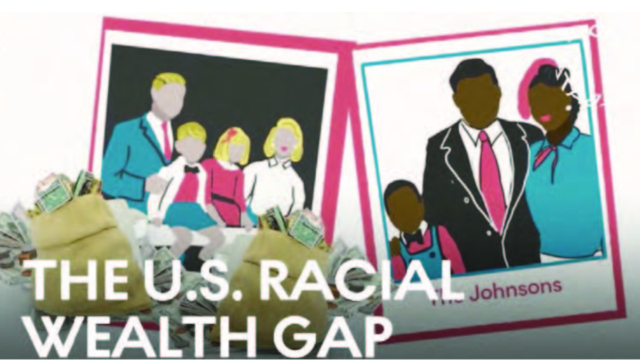
By Karen Juanita Camilo
NY Amsterdam News
This article, inspired by Deloitte research, is part of a series in which five Black-owned publications around the United States explore the key factors that contribute to racial and generational gaps in acquiring wealth.
“The career choices open to Black men?”
Independent economics researcher Chris Lee seems bemused by the question.
“Well, there’s a famous book by William Julius Wilson about when work ‘disappears,’” Lee finally replies.

“Work for high school graduates, that pays well, has disappeared, especially for men and more so for Black men who are high school level graduates—and now it’s happening to some who are in college too.”
Indeed, a 2020 analysis from the U.S. Bureau of Labor Statistics found that Black men have the lowest employment numbers among all ethnic groups. In addition, when Black women are employed, they earn 63 percent less than what a White man would be paid for the same job, according to the analysis.
This unequal access to jobs and reduced earning power presents Black households with fewer opportunities to build wealth through home ownership and the acquisition of stocks.
Those dual pillars of financial well-being are “the largest assets driving wealth creation,” according to a recent analysis of how homeownership and stocks contribute to the wealth gap in America, which draws on data from the Federal Reserve Board’s 2019 Survey of Consumer Finances.
On average, the study finds, White households added $34,400 to their median real wealth between 2010 and 2019, while Hispanic households added $17,100 and Black households only $5,300.
The Intentionality of the Racial Wealth Gap
“The main thing that we need to know is that there was never ‘40 acres and a mule.’ And as a result, we have suffered ever since.”
Black Americans having less wealth than White Americans—the racial wealth gap—“can be traced to slavery and the end of the Civil War when government policies and programs were created to keep Black Americans from prospering in U.S. society,” says Jan E. Christopher, an associate professor of economics in the Department of Accounting, Economics and Finance in the College of Business at Delaware State University.
“The main thing that we need to know is that there was never ‘40 acres and a mule.’ And as a result, we have suffered ever since,” observes Christopher.
The promised 1865 wartime order that would have allotted 40 acres of land and a mule to some 40,000 emancipated African Americans as a form of compensation for being enslaved was never granted.
In a 2021 report, researchers at the Federal Reserve Bank of St. Louis pointed out that historical discriminatory laws continue to hamper Black people from accessing wealth at the same pace as Whites, and called for systematic change.
“Our findings also suggest that historic economic advantages enjoyed by White families continue to influence the wealth accumulation of their descendants,” the report says. “Our research suggests families will be better positioned to fully participate in the economy and realize their full economic potential when race is no longer predictive of starting points,” it concludes.
The report explains how Federal policies like the 1862 Homestead Act, the Social Security Act of 1935, the 1944 G.I. Bill, and multiple levels of discrimination in the criminal justice system have helped the nation maintain a racial—and financial—hierarchy that is still in place to this day.
For example, the Homestead Act granted 160-acre plots of government land to only White people, and the Social Security Act created financial safeguards for the elderly, unemployed, and disabled, but took pains to exclude predominantly African American domestic and farm workers. The G.I. Bill welcomed home returning World War II veterans with access to employment, schooling, and housing, but ended up excluding many Black veterans, according to the report.
Meanwhile, racially restrictive covenants and “redlining” kept Black homebuyers out of “White” neighborhoods with higher property values. This combination of policies and business practices steered them to neighborhoods seen as undesirable—neighborhoods where their homes are less likely to grow in value, thus denying their families access to generational wealth, the report points out.
A Need for Significant, Systemic Change
Reducing the differences in wealth attainment brought about by generations of these policies undoubtedly takes work.
The Federal Reserve Bank of St. Louis researchers noted that “individual actions and marginal policy changes” simply aren’t enough to undo the damage of “systemic barriers like asset poverty, the legacy of wealth-stripping tactics in housing markets, and discriminatory practices.”
Instead, “larger systemic changes” are needed—and there is a call to consider forms of reparations to the descendants of enslaved Black Americans as part of the solution.
For example, in June 2022, California’s Task Force to Study and Develop Reparation Proposals for African Americans released its 500-page interim report detailing “the ongoing and compounding harms experienced by African Americans as a result of slavery and its lingering effects on American society today.”
The task force’s economic consultants estimated that Black Californians are owed $223,239 as compensation for the housing wealth gap.
Similarly, a separate study released in November estimated that payments of $828,055 per household would eliminate America’s racial wealth gap.
A Widening Wage Gap
For the last half-century, the Black community’s tried-and-true methods for economic advancement have been two-fold: either gaining access to higher education—and the salaries that come with post-secondary degrees—or being employed in jobs that pay union wages.
But even with those shifts, the racial wealth gap persists.
“If you look at employment in the United States—let’s say going back to the 1960s—and you look at the share of employment that’s allocated to Whites, to Blacks, and to Hispanics, one of the things that’s really kind of telling is the fact that the share of employment that’s allocated to Blacks and Hispanics has actually increased, but so has the wage gap between Whites and Hispanics, Whites and Blacks,” explains Romie Tribble, Jr., a professor of economics at Spelman College.
Tribble is the secretary of the National Economic Association (NEA), an organization of Black economists founded in 1969.
“One of the things we are looking at is why do these disparities still exist and why are they still widening when there are other indicators that suggest that there are changes that are taking place,” he says.
Christopher, who is also an NEA member, says research shows that the U.S.’s higher-paying jobs tend to go to White workers. Even when Black workers manage to land one of these coveted positions, their pay scale is lower.
The Impact of Inflation
“Inflation is not only coming from the energy sector and the food sector. It’s also coming from the government borrowing sector.”
The analysis of data from the Federal Reserve Board’s 2019 Survey of Consumer Finances found that in addition to Black households having lower average incomes than their White peers, due to inflation, “a larger proportion of their total expenditures typically goes toward necessities such as food, housing, utilities, and transportation.”
As a result, “after paying for necessities, lower-income households have less left over in dollar terms to use for home or stock purchases,” the study concludes.
Christopher adds that rising Federal Reserve interest rates are likely to further pressure Black households.
“Inflation is not only coming from the energy sector and the food sector. It’s also coming from the government borrowing sector,” Christopher points out.
“A lot of Black people, in particular, they’re being crowded out, whereas you have Whites who continue to spend at the same pace,” she said. “Even though [the Federal Reserve] keeps raising interest rates, there’s a whole class of people who are not stopping spending and another class of people who can’t even afford to eat. We have a big divide.”
This reality, and uncertainty as to whether Black workers can maintain their current employment level, particularly as the cost of higher education rises and the number of union jobs shrinks, is further evidence of Black workers’ vulnerability.
“Are reparations the way to go to close the gap?” Tribble asks. “Or are there other ways to close this disparity? Is it about closing the employment disparity? Is it about closing the housing ownership disparity?”
Copyright ©? [2023] Deloitte Development LLC. All rights reserved. This publication contains general information only and Deloitte is not, by means of this publication, rendering accounting, business, financial, investment, legal, tax, or other professional advice or services. This publication is not a substitute for such professional advice or services, nor should it be used as a basis for any decision or action that may affect your business. Before making any decision or taking any action that may affect your business, you should consult a qualified professional advisor. Deloitte shall not be responsible for any loss sustained by any person who relies on this publication.









You must be logged in to post a comment Login